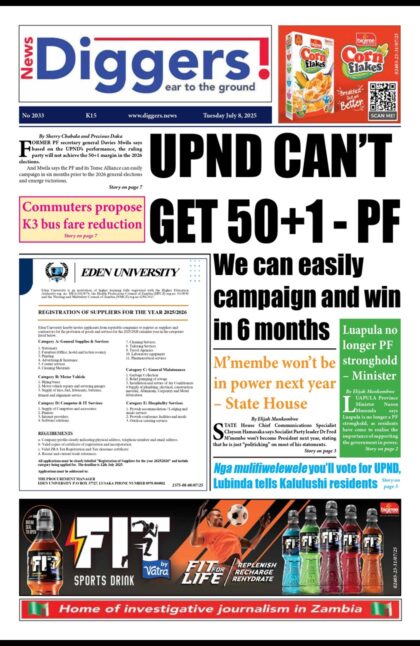Central Statistical Office Director of Census and Statistics John Kalumbi says youth unemployment in the first quarter of 2017 stood at 16.3 per cent.
And Kalumbi says the annual inflation rate for September 2017 has increased to 6.6 per cent from 6.3 percent recorded last month.
During the CSO monthly briefing today, Kalumbi said youth unemployment was estimated at 16.3 per cent.
“Youth (15-35 years) unemployment rate is the number of unemployed youths expressed as a percentage of the youth labour force. Youth unemployment rate in the first quarter of 2017 was estimated at 16.3 per cent. In urban areas, youth unemployment rate stood at 17.0 per cent while rural areas recorded a rate of 15.5 per cent,” Kalumbi said.
He also revealed that unemployment stood at 11.9 per cent.
“According to a strict definition of unemployment, the unemployment rate in Zambia remains relatively low. It is worth noting that most countries often use strict definition of unemployment for international comparison purposes as opposed to a relaxed or broad definition of unemployment which is used to achieve national targets. Further, note that consensus among stakeholders is being built to measure the relaxed definition of unemployment. Using strict definition of unemployment, the unemployment rate was estimated at 11.9 per cent. In rural areas, the unemployment rate was slightly higher at 12 per cent than urban areas,” Kalumbi said.
He also highlighted that of 9,034,435 citizens who were in the ‘working age’, only 3,481,964 were in the labour force while 5,552,471 were outside the labour force.
“58 per cent of the labour force were in urban areas and 42 per cent were in rural areas. It is worth noting that 40 per cent, about 2.1 million persons, were males and 60 per cent were females,” Kalumbi said.
“The employed population was estimated at 3,066,470 persons of which 33.3 per cent, 1,021,889, were in the formal sector, 36.1 per cent, 1,107,712, were in the informal sector while 30.6 per cent, 936,869, were in the households sector.”
And Kalumbi attributed the slight rise in inflation to the upward adjustment of electricity tariffs.
“The year on year inflation rate as measured by all items Consumer Price Index (CPI) for September 2017 has increased to 6.6 percent compared to 6.3 percent recorded in August 2017. This means that on average, prices increased by 6.6 percent between September 2016 and September 2017. The increase in the annual inflation rate was mainly attributed to price increase in electricity tariffs. Of the total 6.6 percent annual inflation rate recorded in September 2017, Food and Non-alcoholic beverages accounted for 2.7 percentage points while non-food items accounted for a total of 3.9 percentage points,” Kalumbi said.
Kalumbi said that the price movements in Lusaka and Copperbelt provinces had the greatest influence on the overall annual rate of inflation.
“Lusaka and Copperbelt provinces had the highest provincial contribution of 1.6 percentage points each to the overall annual inflation rate of 6.6 percent recorded in September 2017. This implies that the price movements in Lusaka and Copperbelt provinces had the greatest influence overall annual inflation. Eastern province had the second largest provincial contribution of 0.9 percentage points. Luapula province had the lowest contribution of 0.2 percentage point,” he said.
Kalumbi further revealed that the country imported more in the month of August 2017 than it exported in nominal terms.
“In August 2017, Zambia recorded a trade deficit valued at K484.3 million from a trade surplus pf K410.6 million recorded in July 2017. This represents a 218.0 percent decrease in the trade balance. This means that the country imported more in August 2017 than it exported in nominal terms,” said Kalumbi.


















